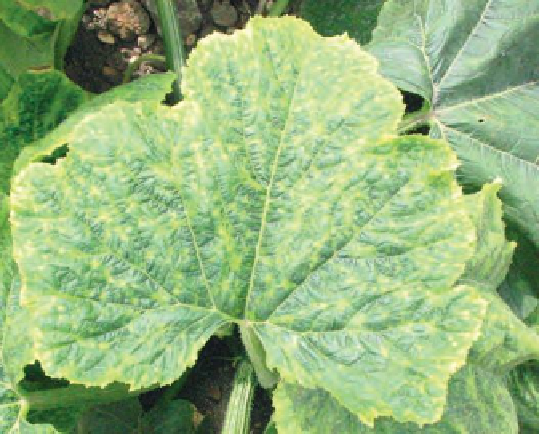Agriculture Reference
In-Depth Information
is composed of a DNA or RNA (see p. 77) core
surrounded by a protective protein coat. On
entering a plant cell, the virus takes over the
organization of the cell nucleus to produce many
more virus particles. Since the virus itself lacks
any cytoplasm cell contents (see p. 77), it is
often considered to be a non-living unit.
The virus's close association with the plant cell
nucleus presents difficulties in the production of
a curative virus control chemical that does not
also kill the plant. No established commercial
'viricide' has yet been produced against plant
viruses. Crops that are propagated vegetatively
(such as potatoes) may continue indefinitely
with the virus inside them if there is no strategy
to remove the virus.
In recent years the broad area called 'virus
diseases' has been closely investigated. Virus
particles have, in most cases, been isolated as
the cause of disease (e.g. cucumber mosaic).
Other agents of disease to be discovered have
been viroids (e.g. in chrysanthemum stunt
disease), and these are even smaller than
viruses.
Mycoplasmas (the cause of diseases such as
aster yellows) are not related to viruses, but
are a group of bacteria that induce symptoms
similar to those produced by viruses.
Figure 19.18
Cucumber mosaic virus
and plum pox), infected seed (e.g. bean common
mosaic virus), seed testa (e.g. tomato mosaic virus)
and mechanical transmission by hand (e.g. tomato
mosaic virus).
Symptoms
. The presence of a damaging virus in a
plant is recognizable to gardeners only by means
of its symptoms. (Commercial: growers may need
to consult a virology specialist, whose identification
techniques include electron microscopy, transmission
tests on sensitive plants such as
Chenopodium
species and serological reactions using specific
antiserum samples.)
Leaf mosaic, a yellow mottling, is the most common
symptom (e.g. cucumber mosaic virus; see
Figure 19.18). Other symptoms include leaf distortion
into feathery shapes (cucumber mosaic virus), flower
colour streaks (e.g. tulip break virus), fruit blemishing
(tomato mosaic and plum pox), internal discoloration
of tubers (tobacco rattle virus, causing 'spraing' in
potatoes) and stunting of plants (chrysanthemum
stunt viroid). Symptoms similar to those described
above may be caused by misused herbicide sprays,
genetic 'sports', poor soil fertility and structure (see
deficiency symptoms, p. 267) and mite damage (e.g.
on raspberry leaves).
In the following descriptions of seven important
viruses, Latin names of genus and species are not
included, since no consistent classification is yet
accepted.
Spread
. A number of organisms (collectively called
'vectors') spread viruses from plant to plant and then
transmit the viruses into the plant. Peach-potato aphid
is reported as transmitting over 200 types of virus
(e.g. cucumber mosaic) to different plant species.
The aphid stylet (see p. 232) injects salivary juices
containing virus into the parenchyma and phloem
tissues, enabling the virus to travel to other parts of
the plant. 'Persistent virus transmission' is seen in
some vector/virus combinations such as peach-potato
aphid with potato virus X, and
Xiphinema
dagger
nematode transmits arabis mosaic. This persistence
occurs because the virus is able to survive and
increase within the vector's body for several weeks.
However, in many vector/virus combinations such
as plum pox, the virus survives only briefly as a
contaminant on the insect's stylet, with the result that
the vector does not spread the virus very far amongst
a population of plants. Other examples of vector/
virus combinations include bean weevils/broad bean
stain virus and
Olpidium
soil fungus/big vein agent
on lettuce. Important methods of spread also involve
vegetative material (e.g. chrysanthemum stunt viroid
19
Cucumber mosaic
Damage.
Several strains of virus cause this disease.
In addition to cucumber, the following may also be
affected: spinach, celery, tomato,
Pelargonium
and






